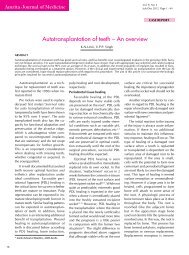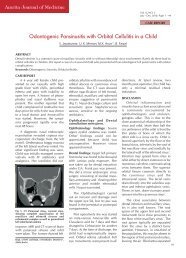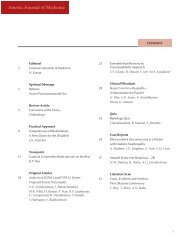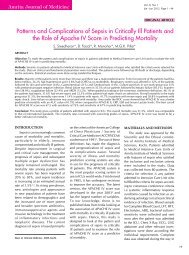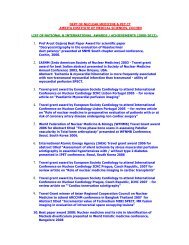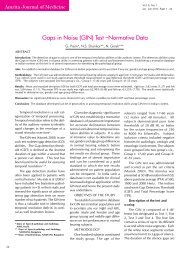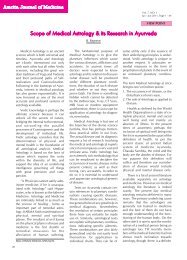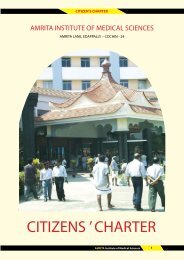Journal of Medicine Vol 2 - Amrita Institute of Medical Sciences and ...
Journal of Medicine Vol 2 - Amrita Institute of Medical Sciences and ...
Journal of Medicine Vol 2 - Amrita Institute of Medical Sciences and ...
Create successful ePaper yourself
Turn your PDF publications into a flip-book with our unique Google optimized e-Paper software.
<strong>Amrita</strong> <strong>Journal</strong> <strong>of</strong> <strong>Medicine</strong><br />
LITERATURE SCAN<br />
Cases, Evidence <strong>and</strong> Verdicts<br />
T. Roy, T. Rony, A.N. Babu<br />
The sixth installment <strong>of</strong> this series<br />
reviews three recent articles<br />
related to neuroprotection in cerebrovascular<br />
disease considering either<br />
primary or secondary prevention<br />
agents.<br />
Y. Lampl MD, M. Boaz, PhD , R.<br />
Gilad MD , M. Lorberboym MD , R.<br />
Dabby,MD , A. Rapoport MD, M.<br />
Anca-Hershkowitz MD, M. Sadeh,<br />
MD :Minocycline treatment in acute<br />
stroke An open-label, evaluatorblinded<br />
study. Neurology 2007;<br />
69:1404–1410<br />
BACKGROUND<br />
Ischemic animal model studies<br />
have shown a neuroprotective effect<br />
<strong>of</strong> minocycline.<br />
OBJECTIVE<br />
To analyze the effect <strong>of</strong><br />
minocycline treatment in human<br />
acute ischemic stroke.<br />
METHODS<br />
An open-label, evaluator-blinded<br />
study was performed. Minocycline at<br />
a dosage <strong>of</strong> 200 mg was administered<br />
orally for 5 days. The therapeutic window<br />
<strong>of</strong> time was 6 to 24 hours after<br />
onset <strong>of</strong> stroke. Data from NIH Stroke<br />
Scale (NIHSS), modified Rankin Scale<br />
(mRS), <strong>and</strong> Barthel Index (BI) were<br />
evaluated. The primary objective was<br />
to compare changes from baseline to<br />
day 90 in NIHSS in the minocycline<br />
group vs. placebo.<br />
RESULTS<br />
One hundred fifty-two patients<br />
were included in the study. Seventy-<br />
Dept. <strong>of</strong> Digital Health, AIMS, Kochi.<br />
four patients received minocycline<br />
treatment, <strong>and</strong> 77 received placebo.<br />
NIHSS <strong>and</strong> mRS were significantly<br />
lower <strong>and</strong> BI scores were significantly<br />
higher in minocycline-treated patients.<br />
This pattern was already<br />
apparent on day 7 <strong>and</strong> day 30 <strong>of</strong> follow-up.<br />
Deaths, myocardial<br />
infarctions, recurrent strokes, <strong>and</strong><br />
hemorrhagic transformations during<br />
follow-up did not differ by treatment<br />
group.<br />
CONCLUSIONS<br />
Patients with acute stroke had significantly<br />
better outcome with<br />
minocycline treatment compared<br />
with placebo. The findings suggest a<br />
potential benefit <strong>of</strong> minocycline in<br />
acute ischemic stroke.<br />
Somchai Laowattana, MD, PhD;<br />
<strong>and</strong> Stephen M. Oppenheimer, MD,<br />
PhD<br />
Protective effects <strong>of</strong> beta-blockers<br />
in cerebrovascular disease. Neurology<br />
2007;68:509–514<br />
OBJECTIVE<br />
Because activated sympathetic<br />
tone is associated with poorer outcome<br />
after stroke, we investigated<br />
whether beta-blocker treatment was<br />
associated with lesser stroke severity<br />
<strong>and</strong> improved outcome.<br />
METHOD<br />
This study prospectively evaluated<br />
111 patients with stroke. Stroke severity<br />
on presentation gauged by<br />
Canadian Neurologic Scale (CanNS)<br />
<strong>and</strong> medication use verified from<br />
medical records. Power spectral<br />
analysis <strong>of</strong> heart rate variability estimated<br />
cardiac sympathovagal tone.<br />
Coagulation <strong>and</strong> inflammatory activity<br />
were assessed.<br />
RESULTS<br />
On multiple linear regression,<br />
betablocker use was the sole independent<br />
predictor <strong>of</strong> less severe stroke on<br />
presentation (95% CI: 0.12 to 1.86:<br />
p =0.03). When CanNS was dichotomized,<br />
multiple logistic regression<br />
revealed that beta-blocker use (odds<br />
ratio [OR] 3.70, 95% CI: 1.24 to<br />
11.01, p= 0.02) <strong>and</strong> female gender<br />
(OR 2.96, 95% CI: 1.14 to 7.69, p=<br />
0.03) were independent predictors <strong>of</strong><br />
CanNS score >8.5. There was no<br />
difference in blood pressure <strong>and</strong> blood<br />
glucose between these two groups.<br />
Beta-blocker treatment was associated<br />
with lower sympathovagal tone<br />
(p = 0.001), thrombin (p = 0.009),<br />
hemoglobin A1C levels (p =0.02),<br />
<strong>and</strong> erythrocyte sedimentation rate (p<br />
= 0.003).<br />
CONCLUSION<br />
Beta-blocker use is associated with<br />
less severe stroke on presentation <strong>and</strong><br />
may be cerebroprotective due to a<br />
sympatholytic effect associated with<br />
decreased thrombin, inflammation,<br />
<strong>and</strong> hemoglobin A1C.<br />
Xiaobin Wang, Xianhui Qin,<br />
Hakan Demirtas, Jianping Li,<br />
Guangyun Mao, Yong Huo, Ningling<br />
Sun, Lisheng Liu, Xiping Xu<br />
Efficacy <strong>of</strong> folic acid supplementation<br />
in stroke prevention: a<br />
meta-analysis.<br />
Lancet <strong>Vol</strong> 369 June 2, 2007<br />
42



